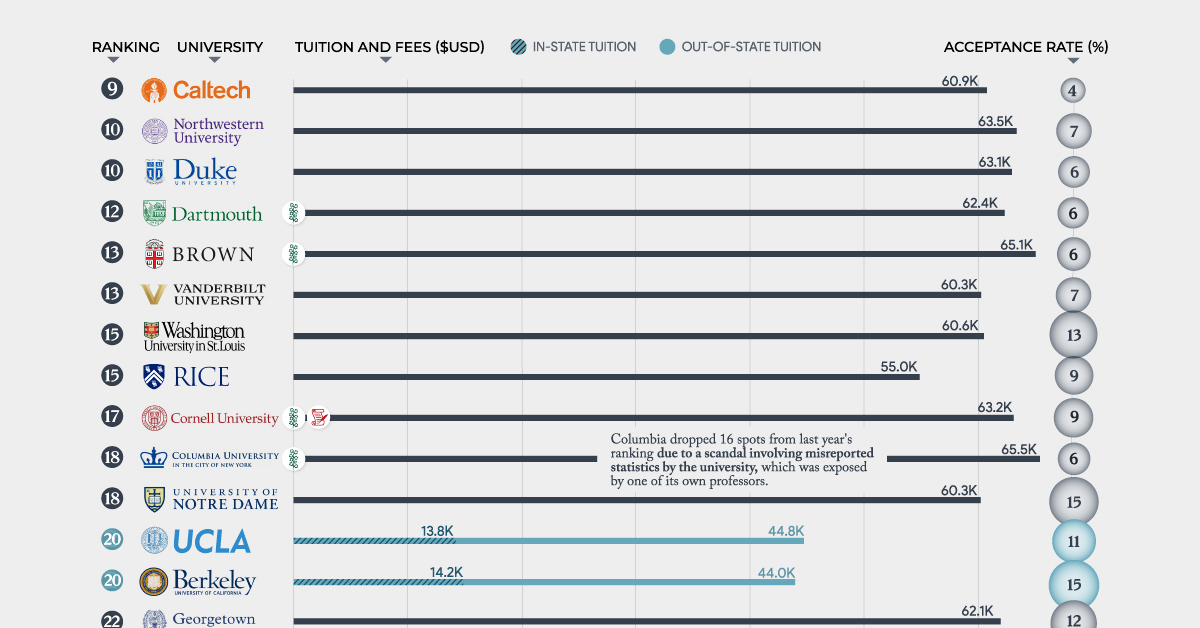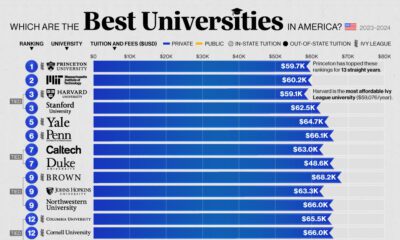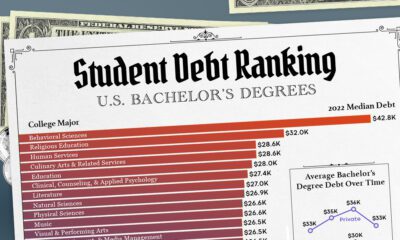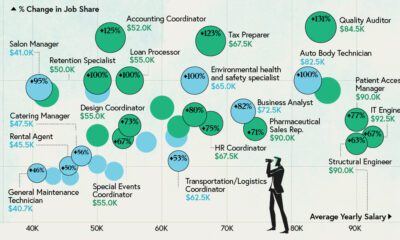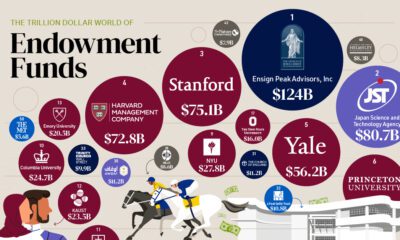Misc
Visualized: The Best Universities in America
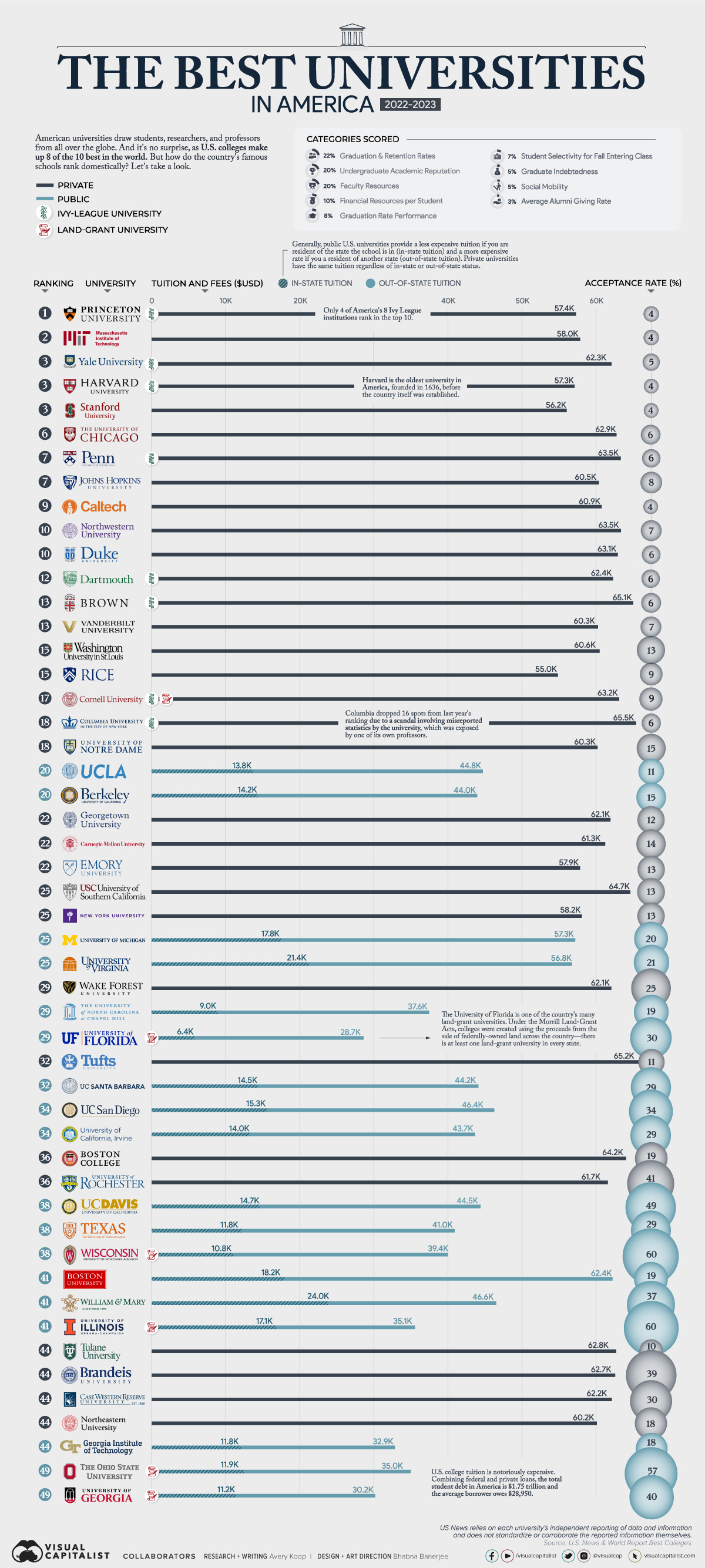
Visualized: The Best Universities in America
The United States is home to many world-class universities like Harvard, Princeton, and Yale, which boast innovative research programs, famous alumni, prestigious awards, and students and faculty from all over the world.
But which schools are actually the best ones in America?
This ranking uses data from U.S. News & World Report to rank America’s 50 best universities from the Ivy League to public institutions. Additionally, this visual shows the average tuition and acceptance rate of each school.
The Methodology
Here’s a look at how different categories are scored in the ranking. It is worth noting that U.S. News relies on each university’s independent reporting of data and information and does not standardize or corroborate the reported information themselves.
How categories are weighted:
- Graduation & Retention Rates = 22%
- Undergraduate Academic Reputation = 20%
- Faculty Resources = 20%
- Financial Resources per Student = 10%
- Graduation Rate Performance = 8%
- Student Selectivity for Fall Entering Class = 7%
- Social Mobility = 5%
- Graduate Indebtedness = 5%
- Average Alumni Giving Rate = 3%
The Top Schools
Ivy League universities are often assumed to be the top schools in America, but in reality, only four of the eight make the top 10.
Here’s a closer look:
| Rank | University | Acceptance Rate | School Type | Tuition and Fees (Private or Public Out-of-State) | In-State Tuition (Public Institutions Only) | State |
|---|---|---|---|---|---|---|
| #1 | Princeton University | 4% | Private, Ivy League | $57,410 | N/A | New Jersey |
| #2 | Massachusetts Institute of Technology | 4% | Private | $57,986 | N/A | Massachusetts |
| #3 | Yale University | 5% | Private, Ivy League | $62,250 | N/A | Connecticut |
| #3 | Harvard University | 4% | Private, Ivy League | $57,261 | N/A | Massachusetts |
| #3 | Stanford University | 4% | Private | $56,169 | N/A | California |
| #6 | University of Chicago | 6% | Private | $62,940 | N/A | Illinois |
| #7 | University of Pennsylvania | 6% | Private, Ivy League | $63,452 | N/A | Pennsylvania |
| #7 | Johns Hopkins University | 8% | Private | $60,480 | N/A | Maryland |
| #9 | California Institute of Technology | 4% | Private | $60,864 | N/A | California |
| #10 | Northwestern University | 7% | Private | $63,468 | N/A | Illinois |
| #10 | Duke University | 6% | Private | $63,054 | N/A | North Carolina |
| #12 | Dartmouth College | 6% | Private, Ivy League | $62,430 | N/A | New Hampshire |
| #13 | Brown University | 6% | Private, Ivy League | $65,146 | N/A | Rhode Island |
| #13 | Vanderbilt University | 7% | Private | $60,348 | N/A | Tennessee |
| #15 | Washington University in St. Louis | 13% | Private | $60,590 | N/A | Missouri |
| #15 | Rice University | 9% | Private | $54,960 | N/A | Texas |
| #17 | Cornell University | 9% | Private, Ivy League, Land-Grant | $63,200 | N/A | New York |
| #18 | Columbia University | 6% | Private, Ivy League | $65,524 | N/A | New York |
| #18 | University of Notre Dame | 15% | Private | $60,301 | N/A | Indiana |
| #20 | University of California, Los Angeles | 11% | Public | $44,830 | $13,804 | California |
| #20 | University of California, Berkeley | 15% | Public | $43,980 | $14,226 | California |
| #22 | Georgetown University | 12% | Private | $62,052 | N/A | District of Columbia |
| #22 | Carnegie Mellon University | 14% | Private | $61,344 | N/A | Pennsylvania |
| #22 | Emory University | 13% | Private | $57,948 | N/A | Georgia |
| #25 | University of Southern California | 13% | Private | $64,726 | N/A | California |
| #25 | New York University | 13% | Private | $58,168 | N/A | New York |
| #25 | University of Michigan--Ann Arbor | 20% | Public | $57,273 | $17,786 | Michigan |
| #25 | University of Virginia | 21% | Public | $56,837 | $21,381 | Virginia |
| #29 | Wake Forest University | 25% | Private | $62,128 | N/A | North Carolina |
| #29 | University of North Carolina at Chapel Hill | 19% | Public | $37,558 | $8,998 | North Carolina |
| #29 | University of Florida | 30% | Public, Land-Grant | $28,658 | $6,380 | Florida |
| #32 | Tufts University | 11% | Private | $65,222 | N/A | Massachussets |
| #32 | University of California, Santa Barbara | 29% | Public | $44,204 | $14,450 | California |
| #34 | University of California, San Diego | 34% | Public | $46,374 | $15,348 | California |
| #34 | University of California, Irvine | 29% | Public | $43,739 | $13,985 | California |
| #36 | Boston College | 19% | Private | $64,176 | N/A | Massachussetts |
| #36 | University of Rochester | 41% | Private | $61,678 | N/A | New York |
| #38 | University of California, Davis | 49% | Public | $44,494 | $14,740 | California |
| #38 | University of Texas at Austin | 29% | Public | $40,996 | $11,752 | Texas |
| #38 | University of Wisconsin--Madison | 60% | Public, Land-Grant | $39,427 | $10,796 | Wisconsin |
| #41 | Boston University | 19% | Public | $62,360 | $18,229 | Massachussetts |
| #41 | William & Mary | 37% | Public | $46,625 | $23,970 | Virginia |
| #41 | University of Illinois Urbana-Champaign | 6% | Public, Land-Grant | $35,110 | $17,138 | Illinois |
| #44 | Tulane University | 10% | Private | $62,844 | N/A | Louisiana |
| #44 | Brandeis University | 39% | Private | $62,722 | N/A | Massachussets |
| #44 | Case Western Reserve University | 30% | Private | $62,234 | N/A | Ohio |
| #44 | Northeastern University | 18% | Private | $60,192 | N/A | Massachusse |
| #44 | Georgia Institute of Technology | 18% | Private | $32,876 | $11,764 | Georgia |
| #49 | The Ohio State University | 57% | Private, Land-Grant | $35,019 | $11,936 | Ohio |
| #49 | University of Georgia | 40% | Private, Land-Grant | $30,220 | $11,180 | Georgia |
One of the Ivies, Columbia University, actually dropped 16 spots from last year’s ranking due to a scandal involving misreported statistics by the university, which was exposed by one of its own professors. There have been critiques of the U.S. News & World Report ranking since, as it doesn’t provide a uniform set of standards for the universities, but lets them determine how they score their categories themselves.
Among the top 10 schools admittance is very competitive, and none of the acceptance rates surpass the 7% mark. Massachusetts Institute of Technology (MIT), Stanford University, and Caltech are among the most difficult universities to get into, with only 4% of applicants receiving that exciting acceptance letter. On the flip side, the universities of Illinois and Wisconsin, for example, accept 60% of all applicants.
Types of Universities
A few more things to know—there are eight private schools in the U.S. that have earned the distinction of “Ivy League,” due to their history and prestige. A number of schools are also classified as land-grant universities—built on land which was essentially given to them by the U.S. government. This was in an effort to provide higher education to lacking communities across the country, and there is at least one in every state.
These are the U.S.’ eight Ivy League Institutions:
- Princeton University
- Yale University
- Columbia University
- Brown University
- Harvard University
- Cornell University
- Dartmouth University
- University of Pennsylvania
Beyond these prestigious academies, there are many high caliber institutions like The Ohio State University and the University of Wisconsin—both of which are land-grant universities.
Among the top 50, there are another four land-grant universities:
- University of Florida
- University of Georgia
- University of Illinois
- Cornell University
There is ripe controversy, however, surrounding land-grant universities, as, in many cases, the U.S. government funded these institutions through expropriated indigenous land.
The Cost of an American Education
U.S. college tuition is famous for being unaffordable. Combining all the federal and private loans in the country, the total student debt comes out to $1.75 trillion and the average borrower owes $28,950.
Here’s a look at how tuition breaks down on average:
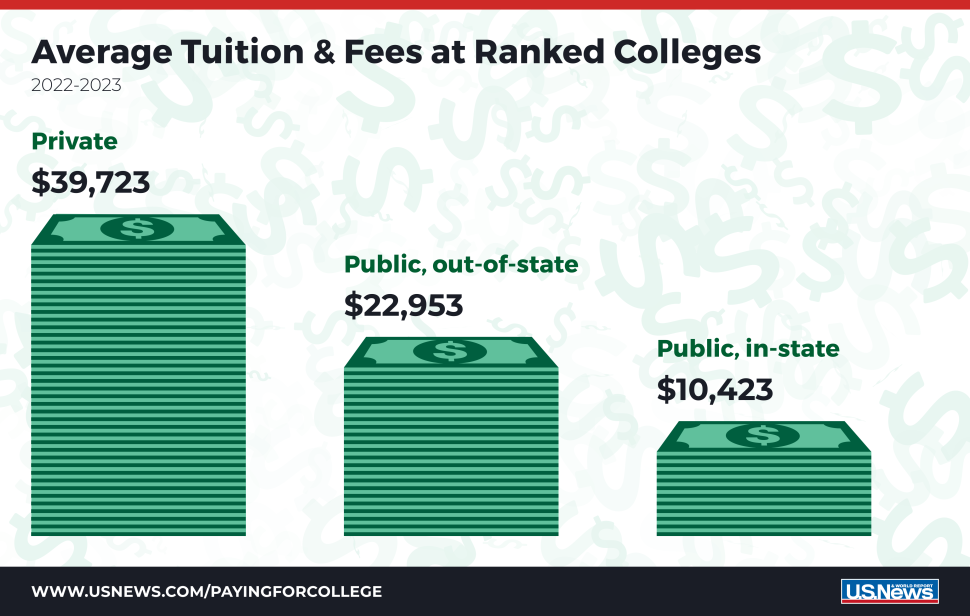
The most expensive school in America is Columbia University, with the cost of admission coming out to a whopping $65,524, with some estimates showing even higher rates for the 2022/2023 academic year. The least expensive among the top 50 is the University of Florida at $6,380 for in-state tuition—more than 10x cheaper than Columbia.
But many Americans may soon see their college loans forgiven. The Biden administration’s initiative to cancel student debt will roll out any day now and will be available on federal loans for select qualifying individuals. It has the potential to provide 40 million people with as much as $20,000 in debt forgiveness.
And given that American universities make up eight of the 10 best universities in the world, perhaps the price tag will be worth it.
VC+
VC+: Get Our Key Takeaways From the IMF’s World Economic Outlook
A sneak preview of the exclusive VC+ Special Dispatch—your shortcut to understanding IMF’s World Economic Outlook report.

Have you read IMF’s latest World Economic Outlook yet? At a daunting 202 pages, we don’t blame you if it’s still on your to-do list.
But don’t worry, you don’t need to read the whole April release, because we’ve already done the hard work for you.
To save you time and effort, the Visual Capitalist team has compiled a visual analysis of everything you need to know from the report—and our VC+ Special Dispatch is available exclusively to VC+ members. All you need to do is log into the VC+ Archive.
If you’re not already subscribed to VC+, make sure you sign up now to access the full analysis of the IMF report, and more (we release similar deep dives every week).
For now, here’s what VC+ members get to see.
Your Shortcut to Understanding IMF’s World Economic Outlook
With long and short-term growth prospects declining for many countries around the world, this Special Dispatch offers a visual analysis of the key figures and takeaways from the IMF’s report including:
- The global decline in economic growth forecasts
- Real GDP growth and inflation forecasts for major nations in 2024
- When interest rate cuts will happen and interest rate forecasts
- How debt-to-GDP ratios have changed since 2000
- And much more!
Get the Full Breakdown in the Next VC+ Special Dispatch
VC+ members can access the full Special Dispatch by logging into the VC+ Archive, where you can also check out previous releases.
Make sure you join VC+ now to see exclusive charts and the full analysis of key takeaways from IMF’s World Economic Outlook.
Don’t miss out. Become a VC+ member today.
What You Get When You Become a VC+ Member
VC+ is Visual Capitalist’s premium subscription. As a member, you’ll get the following:
- Special Dispatches: Deep dive visual briefings on crucial reports and global trends
- Markets This Month: A snappy summary of the state of the markets and what to look out for
- The Trendline: Weekly curation of the best visualizations from across the globe
- Global Forecast Series: Our flagship annual report that covers everything you need to know related to the economy, markets, geopolitics, and the latest tech trends
- VC+ Archive: Hundreds of previously released VC+ briefings and reports that you’ve been missing out on, all in one dedicated hub
You can get all of the above, and more, by joining VC+ today.
-

 Energy1 week ago
Energy1 week agoThe World’s Biggest Nuclear Energy Producers
-

 Money2 weeks ago
Money2 weeks agoWhich States Have the Highest Minimum Wage in America?
-

 Technology2 weeks ago
Technology2 weeks agoRanked: Semiconductor Companies by Industry Revenue Share
-

 Markets2 weeks ago
Markets2 weeks agoRanked: The World’s Top Flight Routes, by Revenue
-

 Countries2 weeks ago
Countries2 weeks agoPopulation Projections: The World’s 6 Largest Countries in 2075
-

 Markets2 weeks ago
Markets2 weeks agoThe Top 10 States by Real GDP Growth in 2023
-

 Demographics2 weeks ago
Demographics2 weeks agoThe Smallest Gender Wage Gaps in OECD Countries
-

 United States2 weeks ago
United States2 weeks agoWhere U.S. Inflation Hit the Hardest in March 2024



